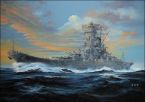Canoerebel
Posts: 21100
Joined: 12/14/2002
From: Northwestern Georgia, USA
Status: offline

|
1/13/45 to 1/17/45
A heckuva big air and naval battle took place near Hong Kong from the 15th through the 17th. Both sides got bloodied, but the results were so extreme for Japane that Miller has indicated he needs a day to decide whether or not to throw in the towel. Here's a summary of what happened:
Battle of Hong Kong, 15th: The Allied CV fleet steamed north through the South China Sea to take station south of Hong Kong. The CVE TFs were to the west perhaps 200 miles. Japanese LBA sortied in big numbers and did moderate damage to CVs Constellation and Ticonderoga, but the Japanese lost nearly 300 aircraft. I ordered the damaged carriers to retire to Samah on Hainan Island and the remaining CV and CVE TFs to combine south of Hong Kong. I figured the "big battle" might be coming, but felt confident that I had enough carrier CAP to win.
Battle of Hong Kong, 16th: Miller sends everything he has at my carriers, including his remaining CVs. Fortunately, he elected to fight at close range (my naval strike aircraft are set at range four to limit "flying off against xAKL TFs). There were massive, massive, massive, never ending sorties by Japanese LBA and carrier aircraft. Allied CAP did a commendable job, but against 25,000 zillion trilliion aircraft the CAP eventually got tuckered out and one big strike made it through. The Japanese scored the following hits: BB Massachusetts 1T; CV Saratoga 1 B, 1 kamikazee; CL Miami 2 TT; and the following CVEs hit: Rudyerd Bay 1B; Barnes (sunk) 2B, 2 TT; Shipley Bay 4B; Shamrock Bay 6T (sunk); Sitkoh Bay 1B, 1 T. Also, a sub put 2 more TT into damaged CV Constellation, so she's really hurting. Japanese air losses were staggering - probably between 500 and 1,000 aircraft.
The Allies got in one good strike on the 16th, doing the following damage: CV Amagi 2B; CV Zuikaku 6B 2T; CV Unryu 1B; CV Katsuragi 3B; nine DDs set afire.
Battle of Hong Kong, 17th: No Japanese strikes make it through the CAP. I'd guesstimate another 250 aircraft lost today.
Allied strike aircraft score the following hits: CV Amagi 4B 1T; CV Katsuragi 4B; CVL Ryujo 3B 2TT; eight DD badly damaged; one CLAA sunk and one moderately damaged.
Japanese Losses: Three CV (Amagi, Katsuragi, Zuikaku), one CVL (Ryujo); plus some 17 DDs heavily damaged or sunk, one CLAA sunk; one CLAA moderately damaged. The Japanese lose roughly 1,000 to 1,500 aircraft during the three-day battle.
Allied Losses: CV Constellation heavily damaged; CV Ticonderoga and Saratoga moderately damaged; two CVE sunk; two CVE heavily damaged; one CVE moderately damaged; one CL heavily damaged; one BB lightly damaged. The Allies probably lost 200 to 300 aircraft, mostly Avengers and Helldivers piloted by low-experienced men (not the more valuable, at least to me, fighters).
Strategic Impact: In the real world, the Allies would be in great shape. It would take months for Japanese air to recover; meanwhile, the Allies can easily replace the aircraft lost, though it will be a month before I can replace the missing flight decks (CV Intrepid, two Brit CVs, and CVL Langley are at Capetown and less than three weeks from being ready to go, and CV Bennington is on the way to Darwin). If things were somewhat normal, I'd retire to port, replace the lost aircraft, and then go wherever I wanted to (meaning sending lots of supplies and troops by ship to Ningpo and/or Wenchow). But in AE Scenario Two it seems that Miller will be able to replace all his losses in a few days, so that the danger level will remain about the same. Anyhow, this was clearly a major Allied victory.
One other Thing: The Allies still have avoided giving Miller the one thing he really wanted - a chance to send zillions of kamikazees and strike aircraft to overwhelm the Allied fleet. Or perhaps its game mechanics that's frustrating him. But the Allies have done well in refusing to send ships places where an ambush would be much easier to arrange and coordinate. (IE, the Allies have remained somewht distant from big airbases and haven't sailed into confined waters between big IJ airfields).
China: An American Army division arrived at Foochow and found an IJA division plus two other infantry units. That's going to be tough. So now I'll turn my hopes on Wenchow and Ningpo, which are lightly held. Troops are nearing both locations.
Points: I haven't seen the turn file yet, but before this battle the Japanese lead had fallen to 2,000 points. At this point it is probably less than 1,000 points. But it has to be tough mentally on Miller to play on the defensive for many, many months of game time; absorbing almost never-ending defeats with little chance of achieving victory anywhere. He's done well to fight so hard so long and I understand if he elects to concede. But he probably won't, the rascall.
< Message edited by Canoerebel -- 7/27/2010 8:17:28 PM >
|
 Printable Version
Printable Version


















 New Messages
New Messages No New Messages
No New Messages Hot Topic w/ New Messages
Hot Topic w/ New Messages Hot Topic w/o New Messages
Hot Topic w/o New Messages Locked w/ New Messages
Locked w/ New Messages Locked w/o New Messages
Locked w/o New Messages Post New Thread
Post New Thread